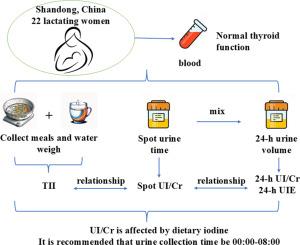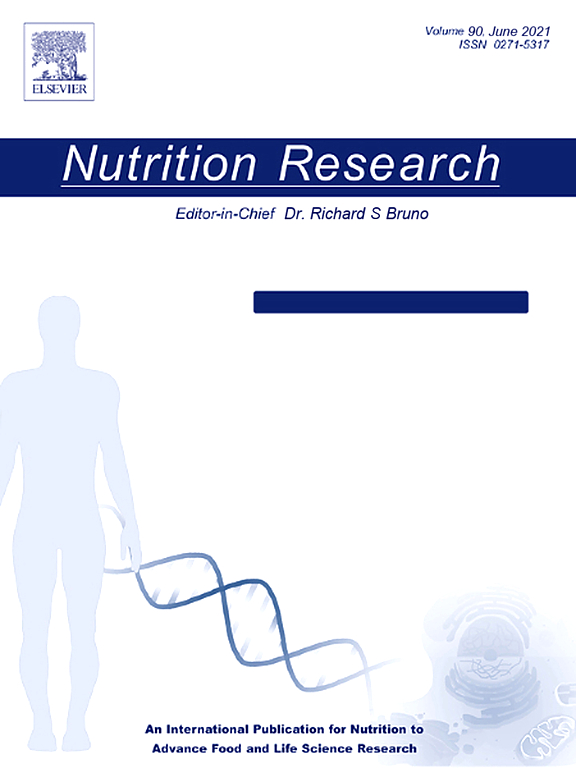尿碘/肌酐作为哺乳期妇女碘状态的指标:最佳采集时间在0-8小时之间
IF 3.1
3区 医学
Q2 NUTRITION & DIETETICS
引用次数: 0
摘要
尿碘/肌酐比值(UI/Cr)已被公认为评价碘营养状况的稳定指标。然而,关于哺乳期妇女尿失禁/尿失禁的数据相对有限。本研究旨在探讨尿样UI/Cr的变化规律,为收集尿液提供最佳时机。选取22名健康哺乳期妇女进行为期7天的碘代谢实验。准确测量和计算每日碘摄入量;在7天的时间内,分别收集所有参与者的尿液样本,并检测尿碘和尿肌酐。现货UI/Cr在00:00 - 08:00之间变化最小,08:00之后变化显著。24小时时段被划分为6个时间段,其中00:00 ~ 03:59时段变异系数最小。混合效应模型分析显示,在0:00 ~ 3:59时段,尿样UI/Cr与24小时尿样UI/Cr的相关性最强(β = 0.82, P < .001),与24小时尿碘排泄量的相关性最强(β = 0.49, P < 001)。4 ~ 7∶59与总碘摄入量相关性最强(β = 0.54, P < 0.001), 20∶00 ~ 23∶59与前一天总碘摄入量相关性最强(β = 0.41, P < 0.001)。由于UI/Cr受膳食碘的影响,且进食后其变化会增大,因此建议采尿时间选择在0:00 - 08:00之间,以此来评价哺乳期妇女的碘营养状况。本文章由计算机程序翻译,如有差异,请以英文原文为准。

Urinary Iodine/Creatinine as an Indicator of Iodine Status in Lactating Women: Optimal Collection Time Between 0-8 Hours
The urinary iodine/creatinine ratio (UI/Cr) has been recognized as a stable indicator for assessing iodine nutrition status. However, data regarding UI/Cr in lactating women are relatively limited. This study aimed to explore the variation regularity of spot UI/Cr and to provide the optimal time for urine collection. Twenty-two healthy lactating women were recruited for a 7-day iodine metabolism experiment. Daily iodine intake was accurately measured and calculated; all urine samples from each participant were collected separately over the 7-day period, and urinary iodine and urinary creatinine were tested. Spot UI/Cr showed minimal variation between 00:00 and 08:00, with significant changes after 08:00. The 24-hour period was divided into six segments, with the smallest coefficient of variation observed in the 00:00 to 03:59 period. The mixed-effects model analysis revealed that spot UI/Cr during the 0:00 to 3:59 period exhibited the strongest correlation with 24-hour UI/Cr (β = 0.82, P < .001), as well as with 24-hour urinary iodine excretion (β = 0.49, P < .001). Additionally, spot UI/Cr during the 4:00 to 7:59 period demonstrated the strongest correlation with total iodine intake (β = 0.54, P < .001), while spot UI/Cr during the 20:00 to 23:59 period showed the strongest correlation with the total iodine intake of the previous day (β = 0.41, P < .001). As UI/Cr is influenced by dietary iodine and its variation increases after eating, it is recommended that urine collection time for assessing the iodine nutritional status of lactating women using spot UI/Cr be set between 0:00 and 08:00.
求助全文
通过发布文献求助,成功后即可免费获取论文全文。
去求助
来源期刊

Nutrition Research
医学-营养学
CiteScore
7.60
自引率
2.20%
发文量
107
审稿时长
58 days
期刊介绍:
Nutrition Research publishes original research articles, communications, and reviews on basic and applied nutrition. The mission of Nutrition Research is to serve as the journal for global communication of nutrition and life sciences research on diet and health. The field of nutrition sciences includes, but is not limited to, the study of nutrients during growth, reproduction, aging, health, and disease.
Articles covering basic and applied research on all aspects of nutrition sciences are encouraged, including: nutritional biochemistry and metabolism; metabolomics, nutrient gene interactions; nutrient requirements for health; nutrition and disease; digestion and absorption; nutritional anthropology; epidemiology; the influence of socioeconomic and cultural factors on nutrition of the individual and the community; the impact of nutrient intake on disease response and behavior; the consequences of nutritional deficiency on growth and development, endocrine and nervous systems, and immunity; nutrition and gut microbiota; food intolerance and allergy; nutrient drug interactions; nutrition and aging; nutrition and cancer; obesity; diabetes; and intervention programs.
 求助内容:
求助内容: 应助结果提醒方式:
应助结果提醒方式:


